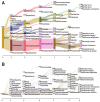Metaprofiling of the Bacterial Community in Colonized Compost Extracts by Agaricus subrufescens
- PMID: 36294560
- PMCID: PMC9605601
- DOI: 10.3390/jof8100995
Metaprofiling of the Bacterial Community in Colonized Compost Extracts by Agaricus subrufescens
Abstract
It is well-known that bacteria and fungi play important roles in the relationships between mycelium growth and the formation of fruiting bodies. The sun mushroom, Agaricus subrufescens, was discovered in Brazil ca. 1960 and it has become known worldwide due to its medicinal and nutritional properties. This work evaluated the bacterial community present in mushroom-colonized compost extract (MCCE) prepared from cultivation of A. subrufescens, its dynamics with two different soaking times and the influence of the application of those extracts on the casing layer of a new compost block for A. subrufescens cultivation. MCCEs were prepared through initial submersion of the colonized compost for 1 h or 24 h in water followed by application on casing under semi-controlled conditions. Full-length 16S rRNA genes of 1 h and 24 h soaked MCCE were amplified and sequenced using nanopore technology. Proteobacteria, followed by Firmicutes and Planctomycetes, were found to be the most abundant phyla in both the 1 h and 24 h soaked MCCE. A total of 275 different bacterial species were classified from 1 h soaked MCCE samples and 166 species from 24 h soaked MCCE, indicating a decrease in the bacterial diversity with longer soaking time during the preparation of MCCE. The application of 24 h soaked MCCE provided increases of 25% in biological efficiency, 16% in precociousness, 53% in the number of mushrooms and 40% in mushroom weight compared to control. Further investigation is required to determine strategies to enhance the yield and quality of the agronomic traits in commercial mushroom cultivation.
Keywords: 16S rDNA; Agaricus blazei; metagenomics; microbiomics; mushroom production; nanopore sequencing.
Conflict of interest statement
The authors declare no conflict of interest.
Figures





References
-
- Tomizawa M.M., Dias E.S., Assis L.J.D., Gomide P.H.O., Santos J.B.D. Genetic variability of mushroom isolates Agaricus blazei using markers RAPD. Ciência E Agrotecnologia. 2007;31:1242–1249. doi: 10.1590/S1413-70542007000400045. - DOI
-
- Colauto N.B., Linde G.A. Avances sobre el cultivo del “cogumelo do sol” en Brasil. In: Sánchez J.E., Mata G., editors. El Cultivo de los Hongos Comestibles en Iberoamérica. Colegio de la Frontera Sur; Tapachula, Mexico: 2012. pp. 103–128.
Grants and funding
LinkOut - more resources
Full Text Sources

